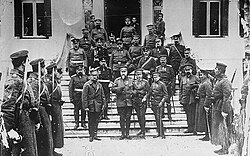Franco-Russian Alliance
| Events leading to World War I |
|---|
 |
|
The Franco-Russian Alliance (French: Alliance Franco-Russe, Russian: Франко-Русский Альянс, romanized: Franko-Russkiy Al'yans), also known as the Dual Entente or Russo-French Rapprochement (Rapprochement Franco-Russe, Русско-Французское Сближение; Russko-Frantsuzskoye Sblizheniye), was an alliance formed by the agreements of 1891–94; it lasted until 1917. The strengthening of the German Empire, the creation of the Triple Alliance of 1882, and the exacerbation of Franco-German and Russo-German tensions at the end of the 1880s led to a common foreign policy and mutual strategic military interests between France and Russia. The development of financial ties between the two countries created the economic prerequisites for the Russo-French Alliance.




The agreements
During
History
The history of the alliance dates to the beginning of the 1870s, to the contradictions engendered by the
At the end of the 1880s, Russo-German economic discrepancies grew stronger. The Russo-French political rapprochement contributed to the influx of French capital into Russia. At the end of the 1880s and the beginning of the 1890s, Russia received a number of large loans from France. The deterioration of Russo-German relations, the resurrection of the Triple Alliance in 1891, and the rumors that Great Britain would join the alliance laid the grounds for the conclusion of a political agreement between Russia and France. It was a response to the formation of a military bloc (the Triple Alliance) headed by Germany. In Europe, two opposing hostile imperialist blocs had formed.[3]

Relying on Russian support, France intensified its colonial policy. After the
See also
- Causes of World War I
- Foreign alliances of France
- French entry into World War I
- Historiography of the causes of World War I
- International relations of the Great Powers (1814–1919)
- List of military alliances
- Military alliance
- Triple Entente
References
- ^ T. G. Otte, "From 'War-in-Sight' to Nearly War: Anglo–French Relations in the Age of High Imperialism, 1875–1898," Diplomacy and Statecraft (2006) 17#4 pp 693–714.
- ^ Norman Rich, Great power diplomacy, 1814-1914. (1992) 216-62.
- ^ Rich, Great power diplomacy, 1814-1914. (1992) pp. 391-407.
- ^ A.J.P. Taylor, The struggle for mastery in Europe, 1848-1918. (1954), pp 325-345.
Further reading
- Albrecht-Carrié, René. A Diplomatic History of Europe Since the Congress of Vienna (1958)
- Bovykin, V. I., & Spring, D. W. (1979). The Franco–Russian Alliance. History, 64(210), 20–35.
- Hamel, Catherine. La commémoration de l’alliance franco-russe : La création d’une culture matérielle populaire, 1890-1914 (French) (MA thesis, Concordia University, 2016) ; online
- Kennan, George Frost. The fateful alliance: France, Russia, and the coming of the First World War (1984) ; covers 1890 to 1894.
- Keiger, John F. V. (1983). France and the origins of the First World War. Macmillan. ISBN 9780333285527.
- Keiger, J.F.V. France and the World since 1870 (2001)
- Mansergh, Nicholas (1949). The Coming of the First World War. London: Longmans Green and Co.
- Otte, T. G. "From 'War-in-Sight' to Nearly War: Anglo–French Relations in the Age of High Imperialism, 1875–1898," Diplomacy and Statecraft (2006) 17#4 pp 693–714.
- Rich, Norman. Great power diplomacy, 1814-1914 (1992) pp 216-62, 391-407.
- Taylor, A.J.P. The struggle for mastery in Europe, 1848-1918 (1954), pp 325–345
